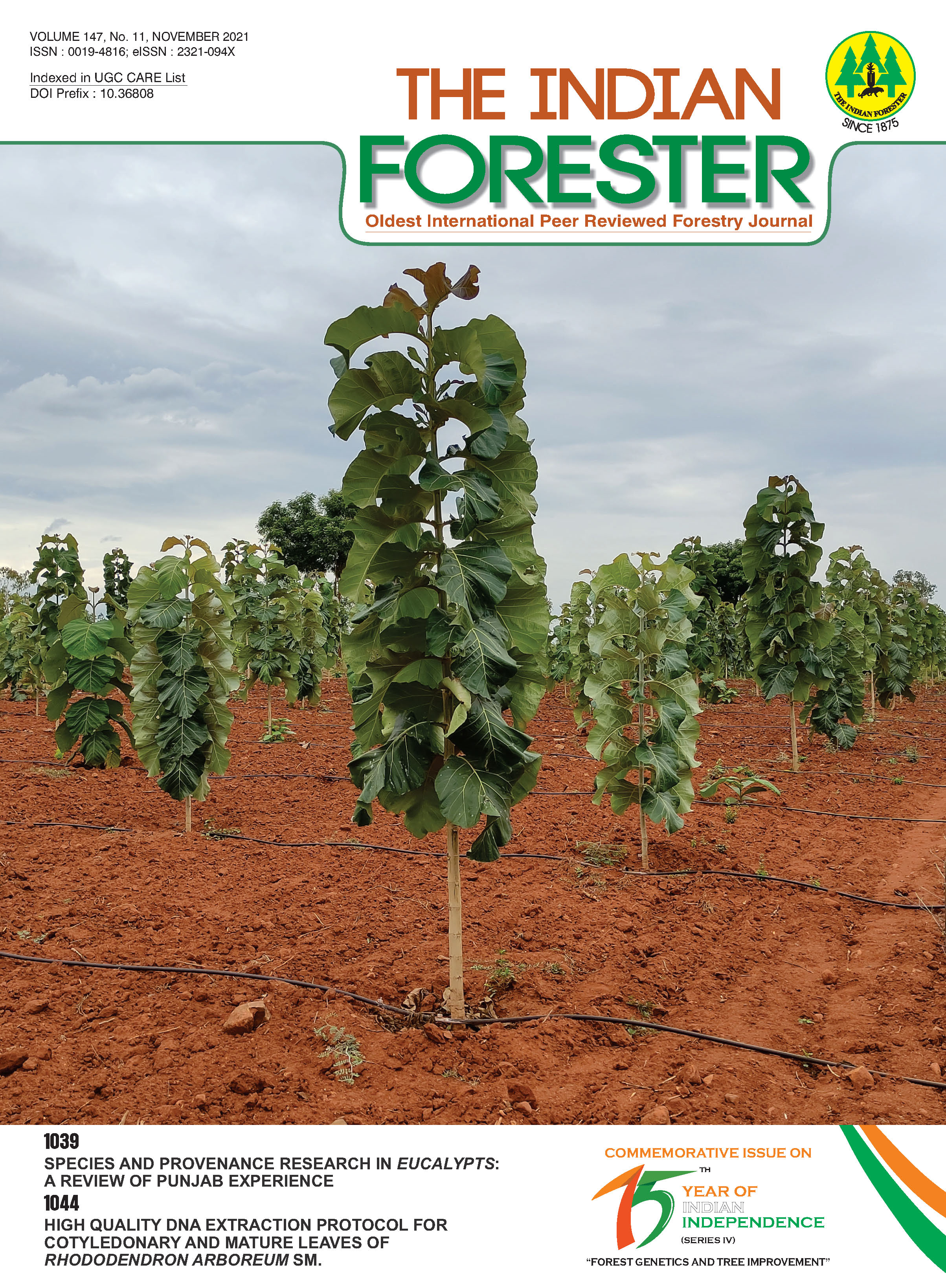Mating System Analysis of Acacia auriculiformis in First and Second Generation Orchard Populations
DOI:
https://doi.org/10.36808/if/2021/v147i11/157116Keywords:
Mating System, Microsatellite Repeats, Out-Crossing Rate, Seed Orchards.Abstract
Acacia auriculiformis A.Cunn.ex Benth is one of the fast growing exotic timber species. Thorough understanding of mating systems is influencing towards an efficient tree breeding design. Thus plant mating systems play an important role in shaping the genetic composition of progeny generations. Institute of Forest Genetics & Tree Breeding (IFGTB), Coimbatore has established Seedling Seed Orchards of Acacia auriculiformis in Southern States (Tamil Nadu and Kerala) of India. Two successive generations of this species were studied for its mating system based on microsatellite markers. Five microsatellite loci were studied among the three hundred half-sib progenies of both first and second orchard populations. Out-crossing rate was estimated The range of the maternal, paternal genotypes among the individuals in the family was also studied in the orchards. The present study indicated high out-crossing rate in first and second generation orchards population and it reflects that this species is highly out-crossed. The gene frequency estimates of the first and second generation progenies were studied that there was no significant variation in the pollen and ovule gene frequency estimate in both generations. The range of the maternal genotypes was 1 to 2 among the individuals in the family. The high out-crossing rate (tm=0.98; SE= 0.05; tm=1.0; SE=0.02) in the orchards indicated that the species is predominantly out-crossed.References
Abdul-Muneer (2014). Application of Microsatellite Markers in Conservation Genetics and Fisheries Management: Recent Advances in Population Structure Analysis and Conservation Strategies, Genetics Research International, (6): 691-759.
Bawa K.S, Perry D.R and Beach J.H. (1985). Reproductive biology of tropical lowland rain forest trees. I. Sexual systems and incompatibility mechanisms. Amer. J. Bot., 72: 331-345.
Bawa K.S., P.S. Ashton and S.M. Nor. (1990). Reproductive ecology of tropical plants: management issues. I n K.S. Bawa and M. Hadley (eds.), Reproductive ecology of tropical plants. The Parthenon Publ. Group, Carnforth, Great Britain. p. 3-162.
Brown A.H.D. (1990). Genetic characterization of plant mating systems. In: Brown, A. H.D., Clegg M.T., Kahler A.L. and Weir B.S. (eds) Plant Population Genetics, Breeding and Genetic Resources, pp. 145—162. Sinauer Associates, Sunderland, MA.
Hamrick J.L., M.J.W. Godt, D.A. Murawski and Loveless M.D. (1991). Correlation between species traits and allozyme diversity: implications for conservation biology. In D.A. Falk and K.E. Holsinger (eds.), Genetics and conservation of rare plants. Oxford University Press, New York, pp. 75-86.
Jithendra Kumar. (2008). Energy production studies of a six year old plantation stand of Acacia auriculiformis at Varanashi. Indian Forester, 134 (8):1037-1044.
Matziris D. (1993). Variation in Cone Production in a Clonal Seed Orchard of Black Pine. Silvae Genetica, 42, 136-141.
Mandal A.K. and Ennos R.A. (1995). Mating system analysis in a natural population of Acacia nilotica subspecies kraussiana. Forest Ecology and Management, 79(3): 235-240.
Mengxue M.A., Xiang DONG , Kuo LIAO , Fei HAO , Rui QIN and Hong LIU. (2019). Outcrossing Rates and Gene Flow in Natural Population of the Endangered Endemic Aquatic Lycophyte Isoetes yunguiensis as Revealed by ISSR Markers. Not Bot Horti Agrobo, 47(2): 339-346.
Melissa A. Millar, David J. Coates, Margaret Byrne, Siegfried L. Krauss, Justin Jonson, and Stephen D. Hopper (2019). Assessment of genetic diversity and mating system of Acacia cyclops restoration and remnant populations. Restoration Ecology, 27(6): 1327-1338.
Moran G.F., Muaona O. and Bell J.C. (1989). Breeding System and genetic diversity in Acacia auriculiformis and Acacia crassicarpa. Biotropica., 21(3), 250-256.
Murawski D.A. and Hamrick J.L. (1991). The effect of the density of flowering individuals on the mating systems of nine tropical tree species. Heredity, 67: 197-203.
Ng C.-H., Lee S.-L., Ng K. K.-S., Muhammad N. and Ratnam W. (2009). Mating system and seed variation of Acacia hybrid (A. mangium×A. auriculiformis). J. Genet., 88, 25–31.
Paola Vanesa Casiva Juan César Vilardi Ana MarÃa Cialdella Beatriz O. Saidman. (2004). Mating system and population structure of Acacia aroma and A. macracantha (Fabaceae). American Journal of Botany, 91(1): 58–64.
Phi Hong Hai, Jansson G., Harwood C., Hannrup B. and Ha Huy Thinh (2008). Genetic variation in growth, stem straightness and branch thickness in clonal trials of Acacia auriculiformis at three contrasting sites in Vietnam. Forest Ecology and Management, 255: 156–167.
Pratima Sinha., Md Aminul Islam., Madan Singh Negi and Shashi Bhushan Tripathi (2015). Estimation of outcrossing rates in interspecific backcross plants of Jatropha curcas (L.) using AFLP and SSR markers. Physiol Mol Biol Plants, 21(4): 605–609.
Ritland K. (2002). Extensions of models for the estimation of mating systems using n independent loci. Heredity, 88: 221228.
Rocha O.J. and Aguilar G. (2001b). Variation in the breeding behavior of the dry forest tree Enterolobium cyclo - carpum Jacq. (Guanacaste) in Costa Rica: a comparison between trees left in pastures and trees in continuous forest. Amer. J. Bot., 88: 1600-1606.
Schlötterer C., Vogl C., Tautz D. (1997). Polymorphism and locus-specific effects on polymorphism at microsatellite loci in natural Drosophila melanogaster populations. Genetics, 146: 309–320.
Schmidt L. (1991). Seed Orchards, Guidelines on Establishment and Management Practices, Silvae Genetica, 42, (2/3): 136–328.
Stebbins G.L. (1950). Variation and evolution in plants. Columbia University Press, New York, USA. Stebbins, G.L. 1957. Self fertilization and plant variability in higher plants. Amer. Nature, 91: 337-354.
Tran Duc Vuong and Maurica Mc Donald. (2002). Out-crossing rates in Acacia auriculiformis A. Cunn.ex Benth, in a seedling seed orchard at Ba Vi, Vietnam, Report for the Domestication of Australian trees project. UNDP/FAO Regional Forest Tree Improvement Project, Field Manual No.4.
Wickneswari R. and Norwati M. (1995). Spatial heterogeneity of out-crossing rate in Acacia auriculiformis A.cunn. ex Benth. In Australia and Papua New Guinea, Population genetics and genetic conservation of forest trees, pp.329-337.
Wright S. (1921). Systems of mating. Genetics, 6: 111-178.
Zobel B.J. and Talbert J. (2003). Applied Forest Tree Improvement, John Wiley & Scons, pp. 505. New York, England.
Downloads
Downloads
Additional Files
Published
How to Cite
Issue
Section
License
Unless otherwise stated, copyright or similar rights in all materials presented on the site, including graphical images, are owned by Indian Forester.





